

Explore the history, culture, people and beautiful landscapes of Vietnam on the 63Stravel travel app
Download the 63stravel app

Phu Tho is known as the ancestral land, not only outstanding with beautiful natural scenery but also a place to preserve historical relics with profound cultural value. With cultural works imbued with history, this place is an ideal place to discover stories about the contributions of our ancestors to building and defending the country. Join 63Stravel to explore 15 historical relics in Phu Tho through the article below!
Top 15 historical relics in Phu Tho for you to explore
Below is a list of historical relics in Phu Tho that are famous for a long time, visitors can visit to experience and explore.
1. Dao Xa Temple
Dao Xa Communal House is a historical relic associated with the legend of Hung Hai Cong - King Hung's younger brother, who openly destroyed land and controlled water. Built during the reign of Le Trung Hung, the communal house went through many restorations, especially in 1930, leaving a unique architectural mark combining the Later Le and Nguyen styles.
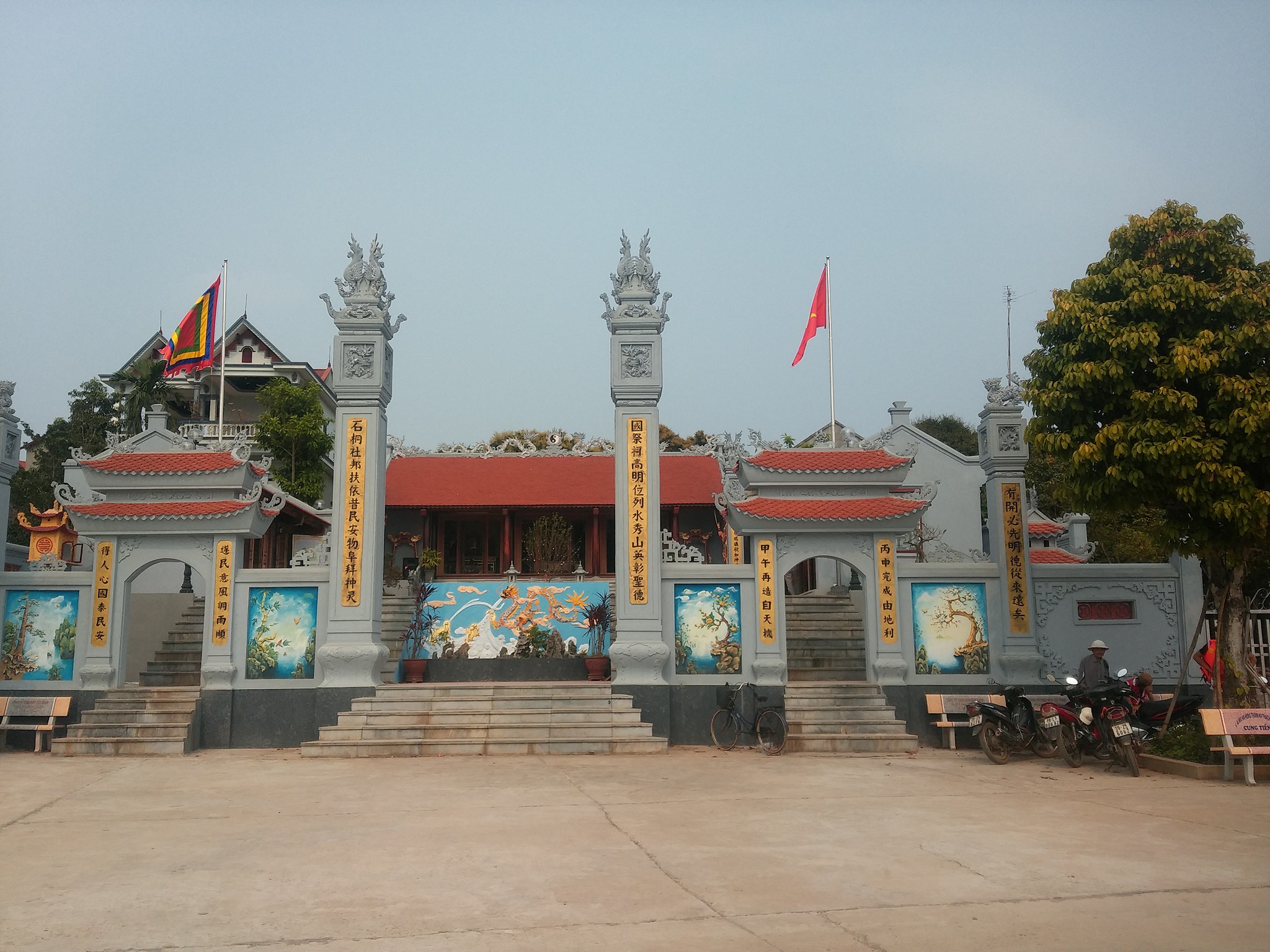
Ancient features of Dao Xa village relic complex
This place not only worships Hung Hai Cong and his three sons but also proves its sacredness with historical stories such as the legend of Ly Thuong Kiet praying here to defeat the Song army. The architecture of Dao Xa communal house with three buildings, exquisitely carved details such as the "Four Spirits", chrysanthemums and agricultural themes, is rich in folk culture and respect for ancestors.
2. Lac Long Quan National Ancestor Temple
The Temple of Father Lac Long Quan, located at the Hung Temple relic site, is a unique architectural work. Newly built with decorative motifs inspired by Dong Son bronze drum culture such as images of people pounding rice and Lac birds.
The temple's architecture includes many outstanding items such as the main temple, gate, pillars, communal house, left vu, right vu and golden floor. All bear the mark of traditional architecture with materials such as wood, stone, and Bat Trang bricks.
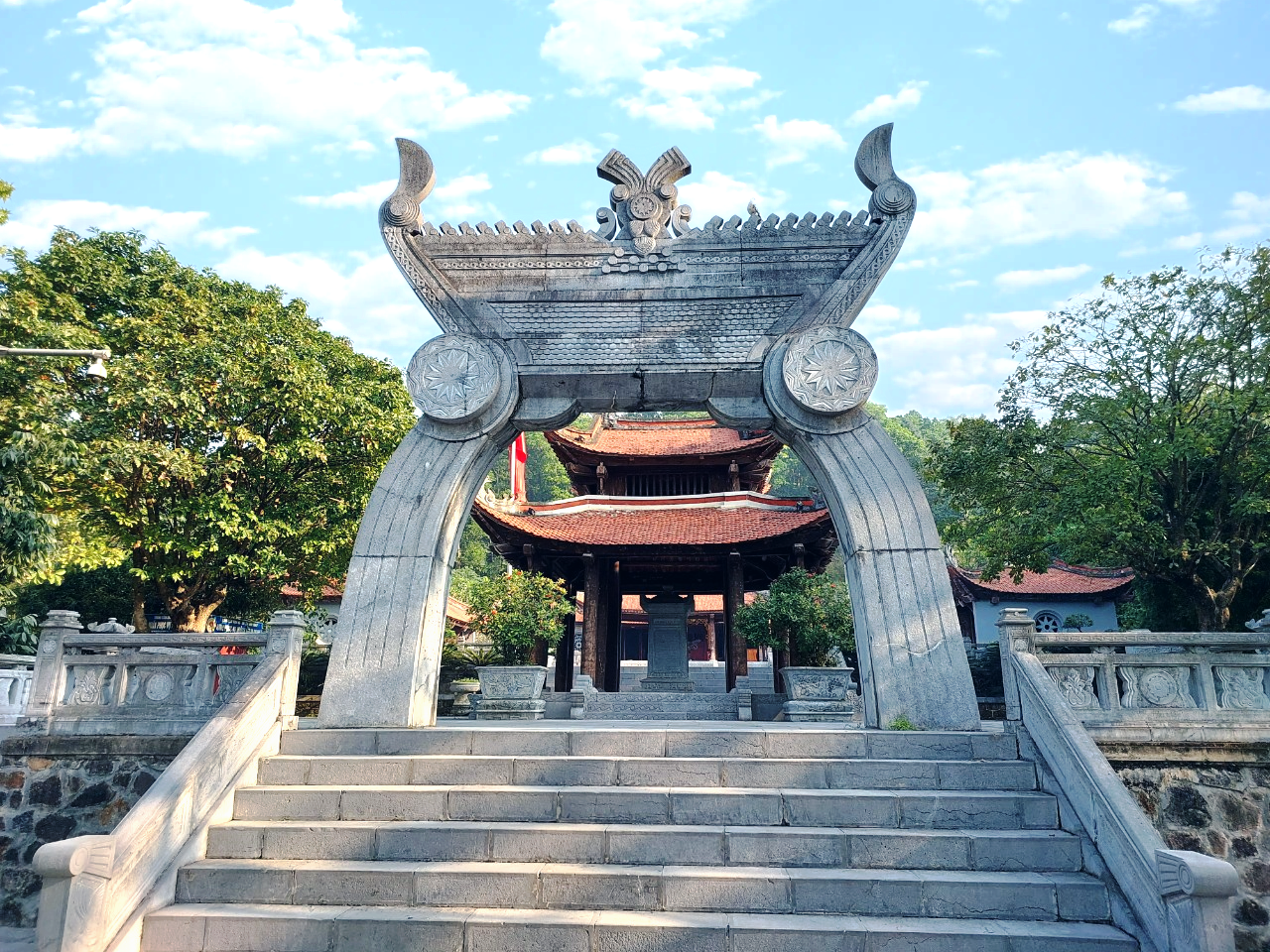
Visit the temple of Lac Long Quan Phu Tho
In particular, the statue of the National Patriarch Lac Long Quan is cast in bronze, weighs 1.5 tons, is 1.98m high, along with two statues of generals and attendants, creating a majestic and solemn worship space. The temple is not only a place to pay tribute to the merits of the Hung Kings but also a meaningful destination, expressing the respect and filial piety of the Vietnamese people.
3. Ha communal house, temple, shrine, Phu Tho province
The cluster of relics of Ha communal houses, temples, and shrines is located on flat, open land in Huong Nha commune, Tam Nong district, Phu Tho province, and is a place to worship the female general Xuan Nuong and the Ten Deities of Mandarins - those who contributed to helping Hai Duong. Ba Trung defeated To Dinh. The relic includes three main works: Ha Dinh, Ha Temple (Ong Temple) and Ha Temple (Ba Temple), each of which has distinct architectural and artistic characteristics, clearly showing the mark of the Nguyen period. .
Ha Communal House has Dinh architecture with 5 compartments, 2 left, structured with 16 sturdy wooden columns, sophisticated artistic decorations, outstanding with the theme "Four Spirits" (Dragon, Ly, Quy, Phuong ).
Ha Temple was built on a high mound, with Nhat-style architecture, with 5 vertical altars, many delicate artistic carvings such as tiger faces and dragon heads flanking each other.
Although Ha Temple is smaller, it still shows meticulousness in design, with elaborate carved details on columns and dragons.
This cluster of relics is not only of historical value but is also an artistic treasure, preserving many precious artifacts such as ordinations, jade genealogies, thrones, palanquins, and sophisticated worship sets, creating creating a spiritual cultural space imbued with national identity.
4. Van Hoi Lagoon
Van Hoi Lagoon is a mysterious destination in the heart of Phu Tho mountains and forests, like a poetic natural picture of the North. Here, you can lie down and relax on the smooth grass, enjoying the absolute silence, where all the noise seems to disappear, giving way to the peaceful space of Van Hoi Lagoon.

Van Hoi Lagoon - "Green lung" at the gateway to the Northwest region
The scenery here is a perfect harmony between the majestic mountains and the calm, vast lake surface. Natural sounds such as the sound of birds singing, the sound of hoes echoing from afar, or the gentle sound of oars on the water surface make you feel the liveliness but also the purity of the heaven and earth here. Van Hoi Lagoon is not just a destination, but an experience of slow living amidst beautiful nature.
5. Au Co Mother Goddess Temple
Au Co Temple in Phu Tho is a famous spiritual tourist destination, attracting tourists with its legends and unique cultural features. Located in Hien Luong commune, Ha Hoa district, the temple was built during the Later Le Dynasty and is a place to commemorate Mother Au Co - mother of 100 children, of whom 50 followed their mother to the mainland, while the eldest child became Hung. Vuong.
The temple stands out with its ancient architecture, including the solemn Au Co statue and many precious antiques. Every year, the Au Co Mau Temple festival takes place during the Lunar New Year, attracting a large number of tourists to participate and pray for good luck.
6. Tien Dong Base Ngo Quang Bich Temple
Tien Dong Base is the place that marks an important part in the life and career of Nguyen Quang Bich - a leader with profound vision and resilient courage. As a "loyal, patriotic" writer, he gave up glory and accepted a life of deprivation and hardship to join the insurgents in building a resistance base in the rugged mountains and forests.
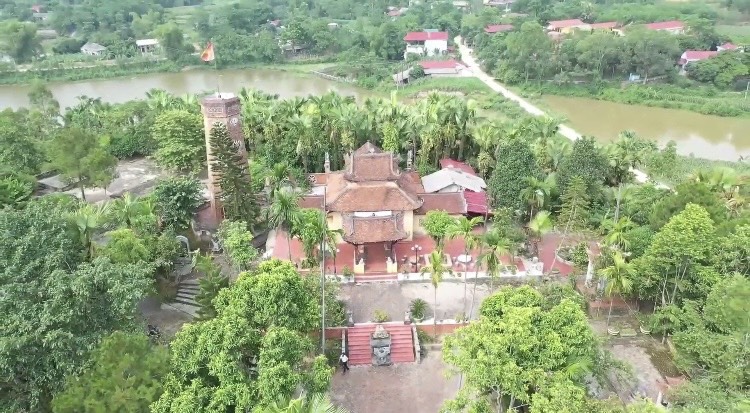
Tien Dong Base Ngo Quang Bich Temple Ranked as a National Relic
It was here, with strategic knowledge and extensive battle experience, that Nguyen Quang Bich took advantage of the terrain, built a solid defense system, turning Tien Dong into a solid base, against the enemy. fierce attacks by the French army. This base is not only a historical relic but also an eloquent testament to his military talent and courage.
>> See more: [Summary] Discover 15+ tourist attractions in Phu Tho worth experiencing
7. Lang Suong Temple
Lang Suong Temple, associated with the era of Hung Kings building and defending the country, is an ancient and sacred temple. This place not only stands out with precious antiques such as Ngoc An and Ngoc Pha but also preserves many unique relics such as the kneeling stone, Thien Thanh well, stomach compression stone and bathing basin.
In particular, the kneeling stone still clearly bears the imprint of Mother Dinh Thi Den - who knelt when giving birth to Saint Tan Vien Son, creating an unforgettable sacred mark. Although Thien Thanh Well is only 3 meters deep, it always remains clear and full of water all year round, further highlighting the mystery of the temple.
The architecture of Lang Suong Temple, with its sturdy brown tiled roof, is not only a historical relic but also a cultural treasure, attracting tourists to visit and worship, especially when hearing about it. legends surrounding the Saint. Ranked as a national monument since 2005, Lang Suong Temple today still retains its ancient appearance, along with spacious space, and is the place where attractive festivals take place on January 15 and October 25 of the lunar month. tourism, attracting a large number of tourists and people to participate in unique folk games.
8. Lau Thuong communal house
Lau Thuong communal house is one of the communal houses with special historical and cultural value, built during the Hung King period and preserving many precious heritages. With Dinh-shaped architecture, the communal house includes a 5-compartment hall and a 3-compartment harem, 28m long and 22m wide.
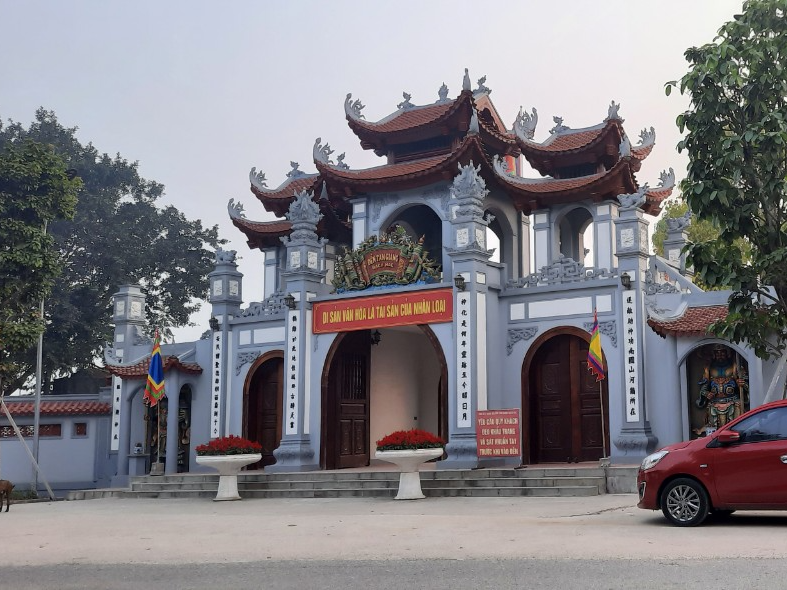
Lau Thuong Communal House - Outstanding historical and cultural relic of Phu Tho province
Built in the Later Le Dynasty (1427-1789), Lau Thuong Communal House not only stands out for its architectural beauty, but also bears a strong mark of folk culture through exquisite carvings depicting stories about Cao Cao. Son Dai Vuong, Quy Minh Dai Vuong and Hai Ba Trung. Images such as "Two Dragons Adoring the Moon", "Dragons Converging" or "Dragon Huan Zi" not only demonstrate great sculpting skills but also reflect the spirit of patriotism and respect for ancestors. predecessor.
The communal house grounds also have a Vat Temple, which is associated with the legend of Tan Vien Son Thanh Thien Quan, further increasing the sacredness and mystery of the relic. With unique historical, cultural and artistic values, Dinh Lau Thuong was recognized as a national historical and cultural relic in 1975.
9. Hung Lo ancient village
Hung Lo ancient village is located peacefully on the banks of the romantic Lo River, only about 5km from Viet Tri city center, and is one of the must-see destinations with unique historical and cultural relics. The Hung Lo Communal House (or Xom Communal House) relic complex is located on an area of 5000m², associated with the tradition of the ancient Kha Lam site, currently in Hung Lo commune.
Hung Lo communal house was built in the Later Le period under the reign of King Le Hy Tong, and is a living museum of folk art culture, a place to preserve the spiritual values of the community through generations. The communal house includes the Dai Dinh, Phuong Dinh, Bell Tower, Drum Floor and Tien Te House, all made from precious woods such as Dinh, Lim, Sen, Tau, Thong Mat, and jackfruit, with tiled roofs. Traditional comedic nose.
The sophisticated artistic sculptures on wood and ceramics at Dai Dinh court not only demonstrate skilled workmanship but also reflect the typical cultural beauty of the Later Le period. When visiting, visitors can not only admire the unique architectural beauty but also feel the soul of folk culture still intact through each project.
10. Song Lo Victory Monument
The Lo River Victory Monument relic site is located on top of Don Mountain, covering a large area of up to 19,300 m², with the main monument occupying 2,000 m². Built with the goal of commemorating the heroic victory, this monument has sophisticated planning, with a stone embankment built in the shape of an arc rising forward. Standing on the monument, visitors can admire the panoramic view of the vast land, where the Chay and Lo rivers blend together, creating a majestic landscape.
The monument consists of two parts: Monument and Statue. The pedestal is 26m high, sturdy as a symbol of strength and national pride, while the 7m high collective statue, made of reinforced concrete painted bronze, depicts the image of 5 elite and great soldiers. representing the forces who fought heroically, contributing to the historic victory of the Lo River. Around the monument are 8 vivid reliefs, depicting great victories in the battle of Lo River and richly depicting images of people and Doan Hung tradition.
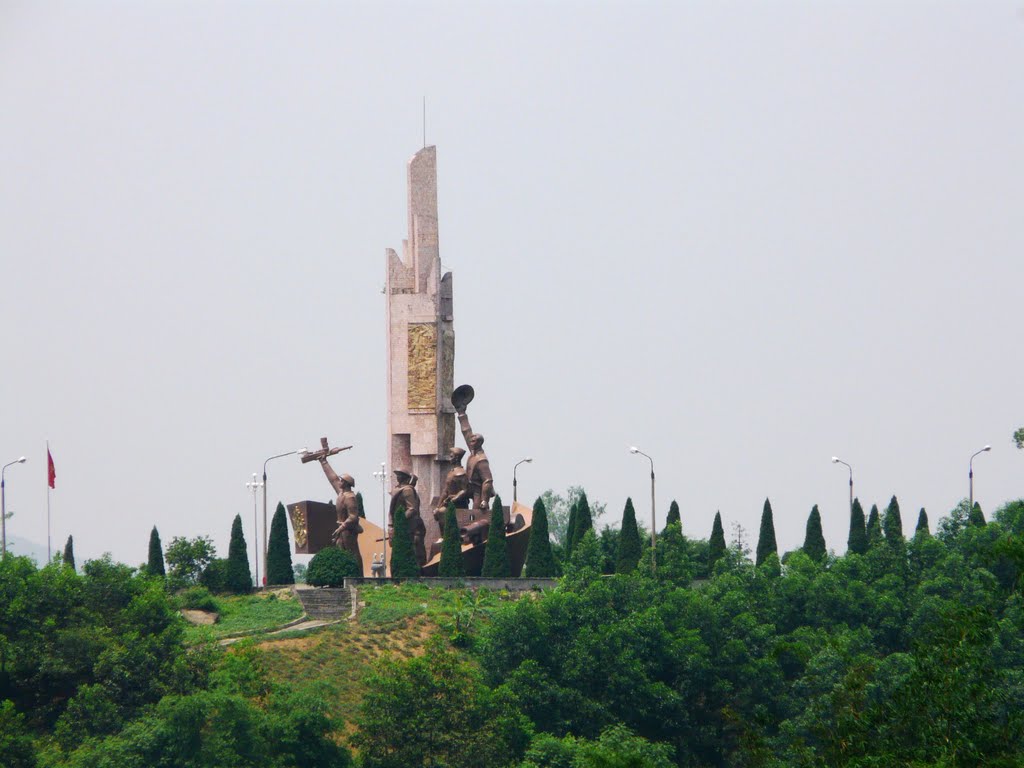
Lo River Victory Monument - An eternal epic
In the middle of Don mountain slope is a house displaying artifacts, recreating heroic achievements of the battle, serving the work of researching and educating patriotic traditions, and welcoming domestic and foreign visitors. The victory of the Lo River, which took place on October 24, 1947, not only marked an important turning point in the resistance war against the French colonialists, but also opened a series of great victories for the Viet Bac army and people. The soldiers and militiamen in this historic battle created unique tactics, such as using "torpedoes" made from grapefruits, causing confusion and catastrophic defeat for the French army.
Lo River Victory Monument was inaugurated in 1987 on the occasion of the 40th anniversary of the victory. It is a national historical and cultural relic, marking the illustrious victories of Phu Tho's army and people, and is also a place to educate patriotism and the tradition of resilient struggle for future generations.
11. Dinh Thach Khoan
Thach Khoan communal house worships Tan Vien Son Thanh - the god symbolizing the nation's cause of building and defending the country. The communal house also worships the three princesses of King Hung and the prisoners of the Dinh family, who contributed to helping King Le Thai To fight the Minh invaders.
The communal house was built in the early 20th century in the shape of the word "Nhat", with 5 rooms and two fortresses, facing Ba Vi mountain. The communal house gate was completed in the period 1930-1940 and through many restorations, still preserves the precious royal decorations and ordinations. In 2001, the communal house was recognized as a National Historical and Cultural Monument.
12. Locust population in Cam Khe
The population of sesame buds in Go Tho, Chuong Xa commune, Cam Khe district, is recognized as a heritage tree, a destination not to be missed when coming to Phu Tho. About 40km from the center of the province, this complex creates a mysterious scene like a dense forest, containing wild natural beauty.
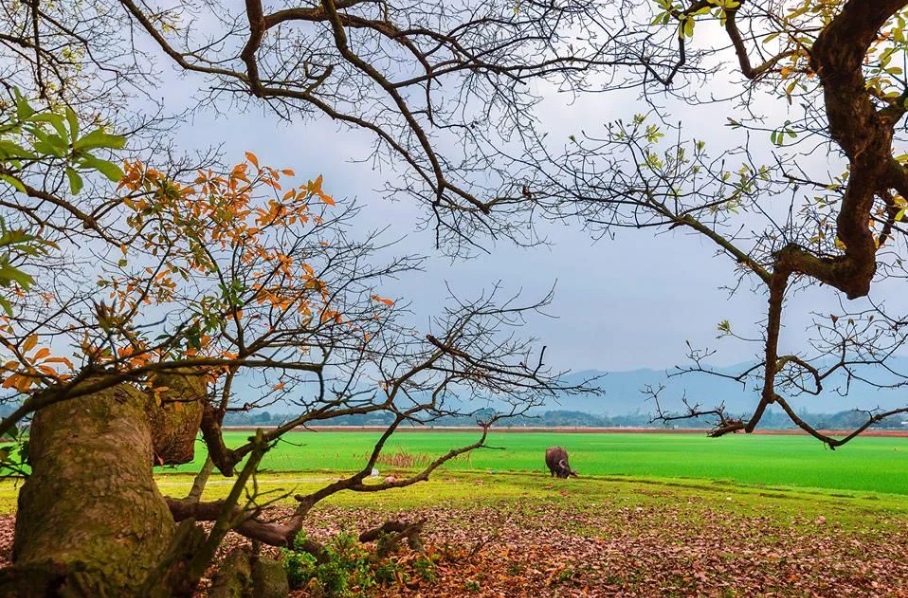
Surprisingly beautiful population of hundred-year-old sesame buds in Phu Tho
According to the Vietnam Association for the Protection of Nature and Environment, the budwood population has more than 80 trees, located on a mound only about 500m² wide, in Lang Chuong lagoon (also known as Vinh mound). Although there are no specific official documents, many people believe that the sesame trees here have existed for more than 1,000 years, witnessing many changes in heaven and earth.
13. Tam Giang Temple relic complex - Dai Bi Pagoda
Tam Giang Temple is located on the left bank of the confluence of the Red River, Lo River and Da River, and is an important historical and cultural relic of Phu Tho. This place not only has Tam Giang temple but also a unified cluster of relics, including Mother Temple, Dai Bi Pagoda and Chieu Van Vuong monument.

Tam Giang Temple relic cluster, Dai Bi Pagoda, Phu Tho - Sacred place where 3 rivers meet
The temple worships three gods: Earth Lenh Cao Quan Bach Hac Dai Vuong, Holy Mother Quach A Nuong, and Chieu Van Vuong Tran Nhat Duat. The temple's architecture is built in the Northern style with a curved roof, meticulous and luxurious decoration. A special feature of the temple is its historical artifacts, including ancient bronze bells and the footprint of the god Tho Lenh, attracting thousands of visitors every year.
>> See more: What should you buy as a gift when traveling to Phu Tho?
14. Lai Len Temple
Lai Len Temple is located in Kim Duc commune, Phu Ninh district, Phu Tho, is an ancient temple associated with the formation and development of Xoan singing. According to legend, the temple was built to commemorate King Hung's teachings of Xoan singing to the children of Kim Duc village.
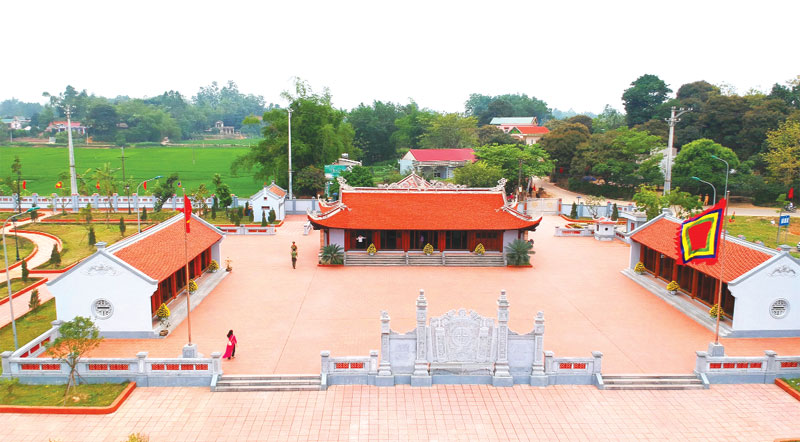
Lai Len Temple - Original relic of the intangible cultural heritage of Phu Tho Xoan singing
The temple has traditional architecture with a curved roof and carvings of four sacred animals. This place is not only a tourist destination but also a religious center for worshiping the Three Holy Kings and preserving Hung Kings culture. Lai Len Temple is a place that attracts tourists to participate in the annual festival and learn about the unique cultural heritage of the ancestral land.
15. Tien Temple
Tien Temple is a place to worship the Mother Goddess - the mother who gave birth to Lac Long Quan and the grandmother of the Hung Kings. This ancient temple is not only a place that marks the legend of King Kinh Duong Vuong's Queen, but also an important spiritual destination in the journey back to the nation's roots. Built at the confluence of the Red, Lo and Da rivers, Tien Temple leans back against the mountain, in front is a place where water gathers, imbued with the spirit of heaven and earth.
The architecture of Tien Temple stands out with its construction style in the shape of the letter "Ding", the funny-nosed tiled roof with dragon and bronze drum motifs, creating an ancient but no less delicate beauty. Going inside, visitors will feel the solemn space, with patterns of bronze drums, diaphragms, parallel sentences and worship statues showing the spirit of the Hung King period.
In particular, the relief behind the statue of the National Mother worships the Vietnamese countryside, bringing a sense of peace and rich national identity. The Tien Temple Festival takes place on the birthday and transformation day of the National Mother, attracting many tourists and devotees to attend and commemorate her merits.
16. Xuan Son National Park
Xuan Son National Park is located in Tan Son district, Phu Tho, is a unique ecological area with typical limestone terrain. With an area of more than 15,000 hectares, this is one of the most important conservation areas in Vietnam, known as the "green lung" of the ancestral land.
With a rich primary forest ecosystem, this place possesses an impressive biodiversity, including 365 animal species. Among them, there are many rare species such as bears, tigers and gibbons, along with 726 plant species, many of which are in the Vietnam and World Red Books.
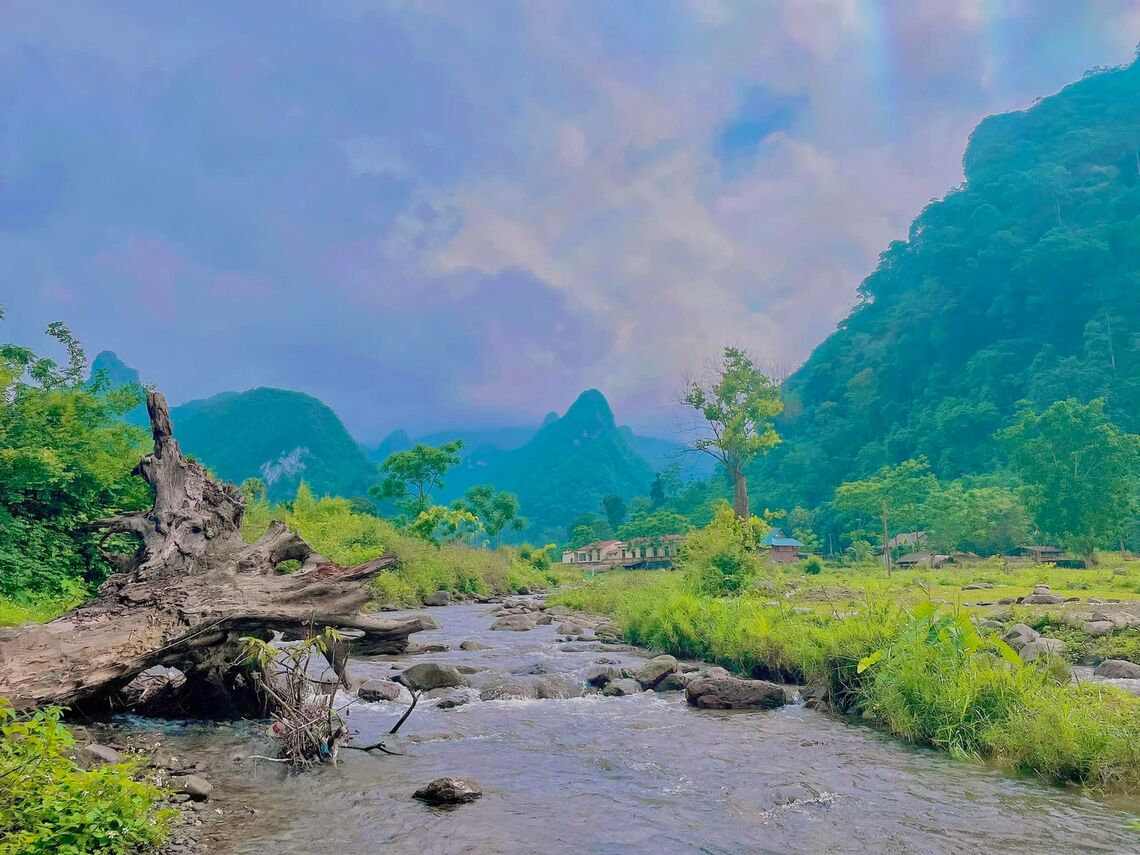
Xuan Son National Park - a green tourist destination not to be missed when coming to Phu Tho
Xuan Son National Park not only stands out with its richness of flora and fauna but also possesses beautiful natural landscapes. Three peaks over 1,000m high, such as Elephant Mountain, Ten Mountain and Can Mountain, are surrounded by hundreds of mysterious caves and majestic waterfalls. Streams such as Lap stream and Thang stream and waterfalls over 50m high create a scene that is both wild and poetic, blending perfectly with the green of the jungle.
Not only has beautiful nature, Xuan Son is also home to ethnic minorities who preserve their unique cultural identities such as traditional costumes, festivals and traditional crafts such as knitting and embroidery. brocade, weaving. These cultural beauties contribute to creating a unique beauty, making Xuan Son an attractive destination for those who love to explore nature and culture.
17. Du Yen Temple
Du Yen Temple, also known as Mother Temple, is located in Bong Chau Thuong area, now in area 2, Chi Tien commune, Thanh Ba district, Phu Tho province. Recognized by the Ministry of Culture and Information as a national architectural and artistic relic in 1993, Du Yen Temple is a historical work, associated with the legend of Princess Ngoc Loan - a talented female general who Help Hai Ba Trung expel the invaders.
The temple is located on Bach Ho hill, about twenty meters above the field surface, with the ground like a saddle, connected to Son Ngoc mound. In front of the temple is the vast Red River, behind is the land surrounding the lotus pond, with Ba Nang and Phuong Hoang hills forming a left dragon position, right white tiger position. According to feng shui concept, this is a sandy land position. benefits for kings.
According to legend, the temple dates back to the early 1st century. It was initially just a simple shrine, but over time, it was built and restored into a spacious building with a 5-room front building and a back building. 3-room palace like today. The temple still preserves many precious artifacts such as exquisitely carved wooden statues, altar thrones, palanquins, halberds, and precious bowls, demonstrating the traditional artistic and cultural values of the nation.
18. Hung Temple
Hung Temple is located in Phu Tho, is one of the prominent cultural tourist destinations, attracting domestic and foreign tourists, especially on Hung King's death anniversary (March 10th of the lunar calendar). This place worships the Hung Kings, the ancestors who built the country, and is a place of pilgrimage for Vietnamese people.
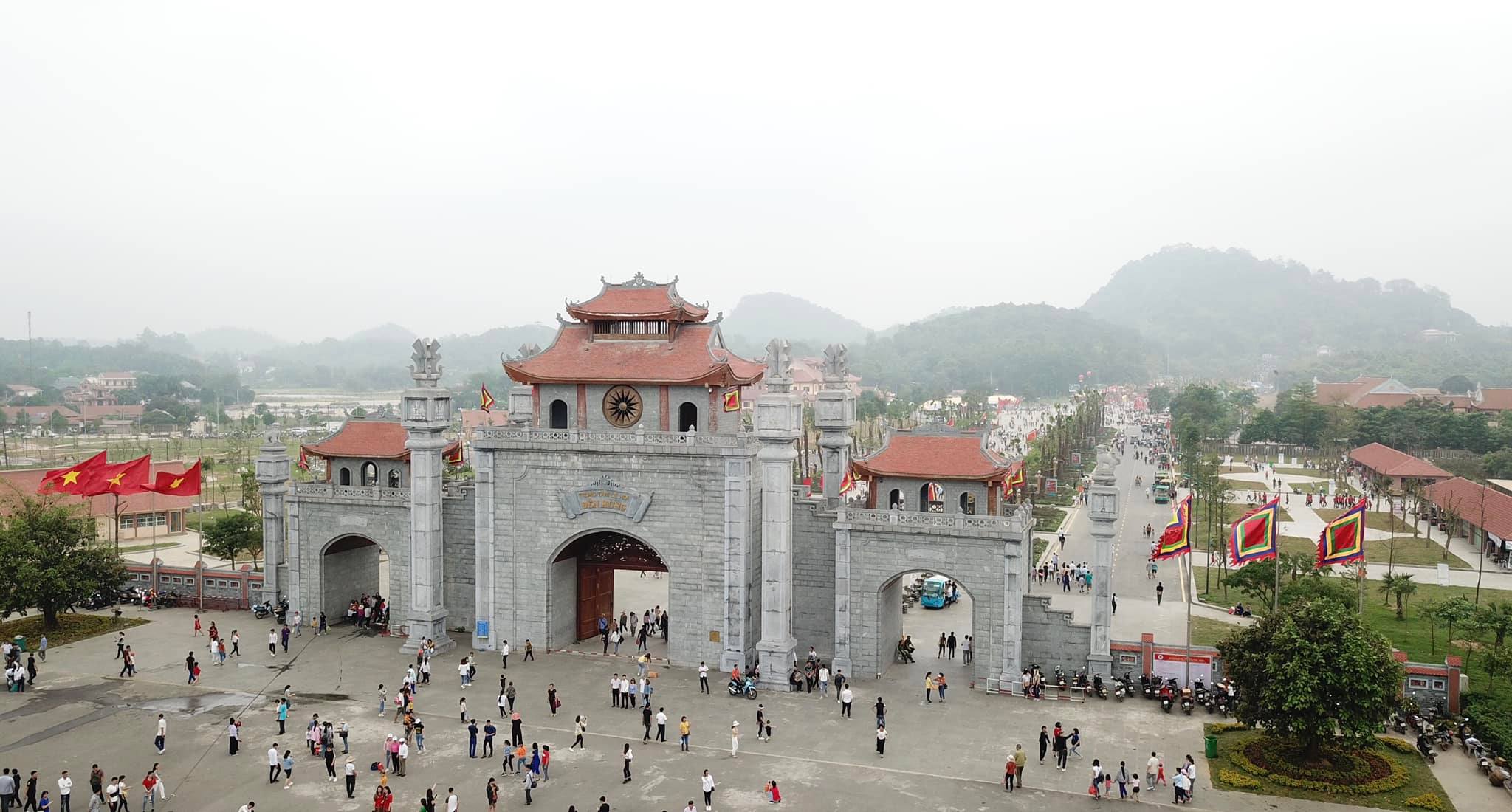
Hung Temple - The sacred place of the nation's origins
The relic site has a majestic terrain, with 4 temples, 1 pagoda and 1 mausoleum, surrounded by beautiful natural scenery. Hung Temple is not only an important cultural heritage but also a testament to the long historical traditions of the Vietnamese people.
Historical relics in Phu Tho are not only sacred places but also living testaments to the culture and history of the Vietnamese people. From Hung Temple to other relics, each destination carries with it special historical and cultural value. Hopefully this article will be a source of inspiration and a useful guide for you in your journey to discover the proud and meaningful ancestral land of Phu Tho.
Phu Tho 2753 view
Update day : 08/11/2024
Hung Temple is a place of worship for 18 generations of Hung Kings and the king's royal family, those who contributed to building the country and are considered the Ancestors of the Vietnamese people. In the past, this land was the capital of Van Lang country, surrounded by two rivers and rolling mountains. That terrain has caused this place to have many rivers, lakes, mountains, hills and fertile alluvium, creating favorable conditions for people to settle down, and at the same time it is easy to defend or retreat in case of disaster. case of conflict. According to scientific documents, the Hung Temple complex began to be built on Hung Mountain during the reign of King Dinh Tien Hoang (968 - 979). Then, around the 15th century, under the Later Le dynasty, the entire relic site was completely built to the current scale. Hung Temple has a total area of 845 hectares with 4 temples, 1 pagoda, 1 mausoleum and many other architectural items, distributed from the foot of the mountain to the top of the mountain, in harmony with the overall majestic landscape. Over time, many relics in the Hung Temple complex have been embellished and supplemented but still retain their ancient and solemn features. For thousands of years, Hung Phu Tho Temple has been a solemn, respectful symbol, closely associated with the cultural and religious life of the nation. Hung King's death anniversary is held on the 10th day of the third lunar month every year and has entered the subconscious of every Vietnamese person with the folk song "No matter who goes back and forth - Remember the death anniversary on the tenth day of the third month". Every year on this day, millions of Vietnamese people from all generations of "Dragons and Fairies" eagerly return to their ancestral land to offer incense at Hung Temple to express their gratitude to their Ancestors and remember their roots. nation and pray for peace, health and good things. With special historical, cultural and scientific value, Hung Temple is ranked as a special national relic according to Decision No. 1272/QD-TTg, dated August 12, 2009 of the Prime Minister. It can be said that Hung Temple is a convergence of profound spiritual cultural values of the Vietnamese ethnic community throughout history. This is expressed very specifically and vividly through the worship of Hung Kings and the Hung Temple festival. Hung Temple Festival is a major festival in Vietnam of national stature, attracting the attention of all Vietnamese people with the blood of "Dragon and Fairy", whether living in the country or abroad. . Since 2012, the worship of Hung Kings has officially been recognized by UNESCO as an Intangible Cultural Heritage of Humanity thanks to its unique and distinct values. This is an important milestone and a great honor not only for the people of our country but also for the entire nation.
Phu Tho 3522 view
February to April
Since ancient times, Mother Goddess worship has become a typical beauty in Vietnamese culture. Many historians believe that this custom comes from the land of Hien Luong (Ha Hoa district, Phu Tho province), where the Au Co Ancestor Temple is located. Under the lush foliage of the ancient banyan tree, countless generations of Lac Hong's descendants have offered incense to pay their respects to Mother Au Co and told each other the legend of the nation's great mother. Legend has it that, the day Au Co was born in Lang Xuong cave (now in Thanh Thuy district, Phu Tho province), there was auspicious clouds protecting her, and a fragrant fragrance spread throughout the space. Growing up, she was beautiful, smarter than most people, read carefully, was good at playing the flute, and was proficient in phonics. After marrying Lac Long Quan - son of Kinh Duong Vuong, Au Co gave birth to a sac of eggs, which hatched into one hundred children. One day, seeing that his children had grown up, Lac Long Quan said to Au Co's mother: "I am a Dragon, you are a Fairy. Although yin and yang come together to form a hundred children, it is difficult to unite because of the different lineages." copper". Having finished speaking, Lac Long Quan led 50 children into the sea. Au Co's mother took her 50 children to the mountains, wherever they went, they conquered people's hearts and cleared the wild forests. One day, passing through Hien Luong, where there were high mountains, wide fields, and long rivers, Mother immediately cleared the land and taught people to cultivate rice, grow mulberries, raise silkworms, and weave cloth. When the farm was beautiful, Mother hurried to a new land. Later, Au Co's mother returned to Hien Luong, remaining attached to this place for the rest of her life. On the 25th day of the twelfth month of the year Nham Than, Au Co's mother flew to heaven, leaving a silk bib under the banyan tree. There, the people built a temple to worship and forever commemorate the National Mother. Au Co Ancestor Temple was officially built during the reign of King Le Thanh Tong (1442 - 1497). The legend of the temple records that the temple is hidden under an ancient banyan tree, facing south, on the left is Loan well, on the right is Phuong well, in front is Giac mountain as beautiful as a script, behind is Giac mountain. The Red River meanders like a sacred dragon surrounding it. Over more than five centuries, the Mother Temple has seriously degraded. In 1998, the Party Committee and people of Hien Luong restored the temple. The temple is not large or massive, but it is highly appreciated for its art. Visitors can find here many relics such as the statue of Au Co, the statue of Monsignor Cao Son, or delicate carvings on the hammock doors, crossbeams, and friezes around the upper palace door. Currently, the main temple has a Dinh-style layout with three harem rooms and five grand worship rooms. Mau Au Co Temple combined with Linh Phuc Pagoda creates a relic complex that has a special attraction for tourists from all over. Ms. Nguyen Thi Tuyet Mai, Head of the Management Board of Au Co Mau Mau Temple Relic Area, said: "With the consent of the government, we are quickly restoring the temple to worship Monsignor Dot Cao Son (the second son of Mau Temple) is located 500m east of Mau Temple to meet the sightseeing and religious needs of the people.
Phu Tho 2099 view
February to May
8km from Au Co Mau Temple, Ao Gioi - Suoi Tien tourist destination is located on Na mountain in Quan Khe commune, Ha Hoa district. This is a tourist destination with wild beauty, fresh and cool air, suitable for tourists who love to explore. According to legend, on the morning of January 7, Mother Au Co went west to No mountain, later called Na mountain, and encountered a rock crevice. She went up the cliff and met a group of fairies who brought down dresses for her. Replace and welcome Mother to heaven according to the Jade Emperor's orders. The water where Mother bathed flowed down to the foot of the mountain, forming a stream, later generations called it Ao Gioi - Suoi Tien and anyone who bathed in Ao Gioi - Suoi Tien for 3 years would have smooth white skin like pearls and a bright face. beautiful like the full moon. The road to Ao Gioi - Suoi Tien has many large and small mountain peaks on both sides, in which Mount Na towers higher than the surrounding mountains. Visitors can take two main routes to visit Ao Gioi, Gieng But, Vuc Xanh, Tien Cave, Bottomless Cave, Ban Che Waterfall, and Canh Tien. Fairy Stream originates from Na mountain, flows through rock crevices like a silver-white silk strip, across the mountainside, standing out among the smooth green of the mountains and forests mixed with the blue of the clouds and sky, creating a poetic scene. just close. Water flows from Na mountain through many waterfalls into a clear stream. The stream bed is thick with gravel and yellow sand, making the stream water pure, clear, and sparkling with reflected sunlight. At the source of the stream is Fairy Well. From the bottom of the well, cool and sweet water sprays out to form Fairy Stream. Fairy Stream winds through many levels and steps, creating many vertical waterfalls. Along the length of the stream, there are many waterfalls, some 20m high, white foam day and night, including Ban Co and Canh Tien waterfalls are the most beautiful waterfalls. Both sides of the stream are covered with a dense green color of tropical plants, crowded together in layers and layers. The wild scenery and fresh air create a rich flora and fauna system in Ao Gioi and Suoi Tien. At the foot of the high waterfalls are giant stone slabs that, over a long period of time, have eroded into small ponds whose bottom is a whole slab of stone, creating a unique beauty here. Ao Gioi - Suoi Tien is still pristine, has abundant tourism potential, can develop all types of climbing, camping, relaxation and scientific research because the flora here is very diverse and rich. rich. Currently, the road to this tourist destination has been paved, making it convenient for visitors to have interesting experiences here.
Phu Tho 2356 view
March to November
According to experience traveling to Xuan Son National Park, traveling here at any time is reasonable because each season has different beauty. In the dry season, the road is easier to travel, can limit more risks, the scenery is fresher and more convenient for going out. But in the rainy season, although the road to Xuan Son National Park may be a bit difficult, visitors will admire the rare, majestic and powerful murmuring waterfall. Depending on each person's needs, the amount of items they carry may vary. Because there are not many grocery stores or places providing consumer services near this tourist destination, visitors must proactively bring clothes, personal items, food (candy, instant noodles, milk...), shoes..etc... If you are more careful, bring a spare battery charger for your phone or camera. When coming to Xuan Son National Park, first, we must mention: Hang Na, Hang Lang, Hang Lun, Thien Nga Cave, Tho Than Cave with many wild, cool and beautiful scenes, close to humans but not Less magical and mysterious. Next, visit the villages in Xuan Son National Park to learn about the culture, primitive and simple life, and unique customs of the people here. Join them to experience daily tasks such as knitting utensils, weaving brocade or fermenting wine, fishing in streams near the village, etc., ensuring that these activities will be no less attractive. interesting. After that, take a walk around the market. Many ethnic items are sold in the market so you can freely choose meaningful items as gifts for friends, relatives or to use for your own needs. me. If you go home during the day, you can proactively eat and drink and bring your own fast food. Otherwise, you have to move to Tan Son town or Viet Tri city to enjoy delicious dishes in Phu Tho. Some suggested dishes are: Phu Tho sour meat, Phu Tho dog meat, cassava vegetable soup stewed with pig's feet...etc. Prices at eateries and restaurants in Phu Tho are very affordable, with absolutely no cutting corners for profit.
Phu Tho 2004 view
March to August
Long Coc tea hill or Long Coc tea oasis is a tourist destination located in Long Coc commune, Tan Son district, Phu Tho province. About 125 km from Hanoi, Long Coc is a collection of hundreds of bowl-shaped hills located one after another. The tea hill area is up to 677 hectares, the tea area that can be harvested is 610 hectares. As a new tourist attraction of Phu Tho province, this place attracts tourists with its poetic and picturesque scenery. Not only can they admire the long, winding green tea hills, visitors to Long Coc also have the opportunity to learn about high-quality tea varieties such as LDP1, LDP2, PH1, PH8... In addition, this is also an opportunity to Great for you to enjoy Shan Tuyet tea and specialty Bat Tien tea. With heavenly landscapes and mild climate, Long Coc is a destination that you can visit at any time of the year. The most ideal time to travel to Long Coc tea hill is from March to December every year. At this time, green tea leaves cover the entire hill, forming vibrant green carpets. From December onwards is the "hibernation" time of tea, tea hills become diverse in lines and shapes, stimulating the imagination of viewers. If you want to take beautiful photos, you should come here early in the morning, which is best in early summer. At that time, the entire space will be immersed in a mist, with a little light light at the beginning of the day. In that atmosphere, everything around was suddenly strangely beautiful and peaceful. Dubbed the "Ha Long Bay of the midlands", Long Coc is one of the most beautiful tea hills in Vietnam. Possessing countless potential for tourism development, this place has no shortage of interesting experiences waiting for you to explore. Long Coc tea hill has a total area of more than 600 hectares, characterized by a lush, picturesque landscape. The hills are undulating, running one after another to the horizon, like giant upside-down bowls. Dotted on that majestic picture of nature are images of workers picking tea, carrying bamboo baskets on their backs and wearing conical hats, so beautiful it's heartwarming. The most beautiful tea hills in Long Coc Phu Tho are Doi 3 and Doi 5 tea hills. These are the two tea hills located at the highest position in the hill system in Long Coc. From here, you can see far away and see the entire lush tea hill landscape. During each season change from autumn to winter, fog thickly covers the hill, creating a poetic and mysterious scene. At dawn, the clouds rush in and blend with the mist to cover the path, making an extremely impressive impression. The stretching green color of Long Coc tea oasis is a super beautiful check-in background for "virtual living" believers. Dawn is the most ideal time for you to take photos of the tea hills. At this time, the tea hills were still sleeping under the mist, the morning dew condensed on the leaves, creating a scene that was as dreamlike as reality, as beautiful as a fairyland. One of the most interesting experiences when coming to the green tea capital of Long Coc is enjoying the specialties here. Visiting this land, visitors must definitely try the following list of dishes: Thanh Son sour meat, Banh tai, Braised fish filling, Banana stir fry,... and many other delicious dishes.
Phu Tho 2086 view
From March to December
Favored by Mother Nature, Thanh Thuy Hot Mineral possesses underground water with temperatures ranging from 45 to 60 degrees Celsius all year round. In recent years, Thanh Thuy Hot Minerals is a Phu Tho tourist destination that has attracted the attention of many people, especially those who are concerned about health issues. As the first hot spring source in the Northern region rich in Radon content that can strengthen the immune system, it is not surprising that this is a tourist destination with a large number of people visiting each year. In particular, today, the resort's campus is also designed with more entertainment areas and amenities such as swimming pools and restaurants to give people more options. Thanh Thuy hot mineral water is the result of geological tectonics. The water temperature is always hot from 45 to 60 degrees Celsius all year round, even on rainy season days. The nutrients in water have the effect of beautifying, treating skin diseases, good for the heart as well as increasing immunity. Coming here, you can relax and soak in Thanh Thuy hot mineral water to circulate blood and relieve stress after busy days at work. Within the resort grounds, there are saunas, mud baths, jacuzzis and swimming pools for everyone to choose from. Besides bathing in Thanh Thuy hot spring, when you come here, you also have the opportunity to enjoy a series of specialties of the ancestral land of Phu Tho. The resort's restaurant is designed in the style of a stilt house, located right next to the lake so it is always cool and airy. The restaurant's menu is very diverse, mainly local specialties, such as Da River barb fish, lentil fish, carp, wild boar, hill chicken and mountain goat, etc. The dishes are seasoned with local flavors and made from fresh ingredients, promising to bring you memorable culinary moments. In order to bring memorable moments of relaxation to everyone, Thanh Thuy hot mineral tourist area also arranges tennis courts, karaoke rooms, fishing, bicycles and campfires. Surely your trip back to the ancestral land of Phu Tho will be more memorable and unique than ever.
Phu Tho 2213 view
From January to December
Located in the ancient village of Hung Lo with a date of more than 300 years old, Hung Lo communal house has long entered the consciousness of Vietnamese people with customs and practices associated with the belief of worshiping Hung King. Hung Lo ancient village (Hung Lo commune, Phu Tho province) is located on the banks of the romantic Lo River, about 5km from the center of Viet Tri City. Hung Lo Communal House's historical and cultural relic complex was built on a land area of 5,000 square meters. Legend has it that in the reign of Le Hy Tong (1967), people here built a temple to worship the 18th Hung King, facing Nghia Linh mountain, where the Hung King's capital was located. Hung Lo Ancient Communal House is a complex of historical and cultural relics built on a large strip of land, including many construction items such as: Dai Dinh, Phuong Dinh, Bell Lau, Drum Lau, Sacrifice House... All are Built with rare types of wood such as nails, ironwood, bamboo, etc. The Great Court is structured according to the traditional architecture of three compartments, two wings; All three rooms have altars. The altar rooms are built according to the structure of five compartments and two wings. On both sides of the communal house are the Buddhist temple and the Shen Nong altar. The communal house's yard is spaciously decorated with rockery, sycamore trees, and shady banyan trees. This place also preserves a system of worship objects to serve the most complete worship rituals; In particular, the system of ancient couplets is very rich with 43 couplets praising the scenery of the homeland and the merits of King Hung. Most of the ancient worship objects are over 300 years old, typically 5 red-painted palanquins and gilded palanquins and festive symbols. Another notable feature, Hung Lo communal house is very famous for its tradition of the Hung Temple palanquin festival from ancient times to present. In the year of Mau Ngo (1918), Hung Lo communal house was awarded the "First Hung King Commemoration"; Currently, this reward sign is still solemnly kept in the communal house. On the occasion of the annual Hung Temple festival, coming to Hung Lo communal house, visitors will be immersed in a grand palanquin procession of over 200 men, wherever they go, it stirs up the whole region. The procession will go from the village communal house to Hung Temple; Returning from Hung Temple, the offerings at the village communal house were conducted, and finally the ceremony was held at Elder Yen's house. Source: Phu Tho Tourism Promotion Information Center
Phu Tho 2019 view
Song Lo Victory Monument is located on Don Mountain in Chi Dam commune, Doan Hung district. At the foot of the mountain, the Lo and Chay rivers merge here, creating a charming terrain and rich land. Standing in the monument area, looking far away, you will see the vast green river, close to the roofs and hamlets. Song Lo Victory Monument was built in 1987 with a total planning area of up to 2,537 m2; includes two parts: statue and monument. On both sides of the monument are two symbols of the ship's hull and soaring waves to represent the historical image: The victorious ship carrying the combined strength of the Vietnamese people is sailing out to sea following the flow of history. The 26m high pedestal next to the 7m high statue group is made of concrete and reinforced steel, painted in imitation bronze on the outside. The Victory Monument bears the image of a fire, symbolizing the strong vitality and everlasting existence of the Lo River victory; The body of the pedestal is designed with massive angles and is covered with stones that fit tightly together. On the four surrounding sides of the memorial, there are eight ceramic reliefs depicting the victory of Song Lo and summarizing some typical features in the life of the people of Doan Hung land. Each of the above reliefs is a delicate and elaborately sculpted work of art. The group of victory statues right at the foot of the monument, the statue's face facing the clear blue Lo River includes 5 characters representing the elements and forces he used to participate in the fight to win the Song Lo victory. Each statue is depicted standing and has a different charisma; There is a statue of a soldier in a proud posture holding a gun high, wearing a guard shirt, carrying a bag of rice on his back, and wearing rubber sandals; There is a statue of a soldier holding a rifle with both hands in a ready-to-fight position; The statue in the middle is the image of an ethnic female guerrilla, her head covered with a scarf, her hand holding a stick, her eyes looking into the distance, ready to fight; There is also a statue of a soldier standing next to a cannon, raising his hat and waving, his shirt fluttering in the wind, revealing a healthy, bare chest full of vitality... The above statues vividly portray the historical figures of the people who created the Song Lo victory, carrying the breath of years of heroic fighting to pass down to posterity in a complete and authentic way. . Many years have passed, generations of people born and raised, attached to this majestic land, all carry within them a great pride every time they mention the resounding victory of their ancestors. In their eyes, the Song Lo victory monument is not only a work honoring and praising the Song Lo victory but also a testament to the resilience of their ancestors who sacrificed themselves to protect the Fatherland. Song Lo Victory Monument was recognized as a national historical and cultural relic on September 27, 1997; Source: Phu Tho Tourism Promotion Information Center
Phu Tho 2002 view
Lau Thuong Communal House was built in the Dinh style, including a 5-compartment, 2-room worship hall and a 3-compartment harem, with a length of 28m and a width of 22m in the Southeast direction. The entire communal house has 60 large columns with a diameter of 0.75m linked with horizontal and vertical beams to form a frame with a sturdy structure in the shape of four boat valley pillars. The harem has a unique structure and is exquisitely carved. On the upper beam are two dragons flanking the moon with a tight layout, a harmonious combination of dragon-shaped lines and shapes intertwined with clouds, carved in the style of the Nguyen Dynasty. Below are two elaborately carved residual ends. The entire middle space of the harem is reserved for worship. The main structure of the altar is covered with four roof pillars, outside is a delicately carved door painted in red and gilded gold. Outside the forbidden door on the altar there is also a statue of Hai Ba Trung, carved in a sitting position. The communal house also retains a palanquin with bowls and bowls of tribute, painted and gilded with intricate carvings in the style of the post-Le period. Lau Thuong Communal House currently preserves a number of valuable artifacts such as 4 thrones and gilded tablets crafted during the Nguyen Dynasty, placed in the main altar. Besides, many classic stories such as: "Teaching Mister", "Double Phoenix Ham Thu", "Two Dragons Adoring the Moon", "Dragons Gathering", "Mother Dragon Trains Her Child"... are depicted in paintings. Elaborate carvings on architectural structures. Each carving is a unique work, vividly expressing the simple, liberal beauty, talent, ingenuity, creativity and aesthetics of our ancestors in the past. Lau Thuong village festival takes place on January 9 every year to perform worship rituals and participate in folk cultural and sports activities. Before the main festival, many sports and physical exchange activities between residential areas in the commune took place. On January 9, people organized a palanquin procession from the Ngoai Communal House to the Noi Communal House to celebrate, Then the procession took the palanquin to the front of Dinh Ngoai's temple and continued the ceremony. The annual festival of Lau Thuong village has great significance in connecting the community and educating the nation's patriotic traditions. With precious cultural and artistic values, Lau Thuong communal house was recognized and ranked as a national historical and cultural relic on February 21, 1975. Now when coming to Viet Tri city, tourists in addition to worshiping the Hung King temples on Nghia Linh mountain, visiting Hung Lo ancient communal house to listen to Xoan singing, sightseeing at Thien Co Temple... can also visit Lau Thuong communal house, Feel the ancient and quiet features of this precious architectural sculpture, calm your heart after a busy life to better understand and appreciate the cultural and historical values left by your ancestors. Source: Phu Tho Tourism Promotion Information Center
Phu Tho 1980 view
Du Yen Temple, Chi Tien commune is located in a spiritual land on a high hill, with lush green trees; At the foot is a clear blue lake all year round. The temple faces the Thao River, which is calm day and night, accumulating alluvium. This long dike strip is the provincial road, an important traffic artery of Thanh Ba district. In 1993, Du Yen Temple was recognized by the State as a national historical relic site. In 2003, Du Yen temple was restored to include a 5-compartment front hall and a 3-compartment harem like today. In the temple, there are still many precious artifacts such as: altars, palanquins, halberds, precious bowls, bronze plaques, written in Vietnamese on both sides... The statues are all carved from wood. In addition to the ordinations of the Dinh, Ly, Tran, and Le dynasties, this is the only temple that retains a genealogy recording two thousand years of development of a clan in Thanh Ba land. According to Ngoc Pha, in the past, in the Thao Giang area, at Bong Chau site, now Tien Chau village, Chi Tien commune, Thanh Ba district, Phu Tho province, there was a Nguyen family who lived a gentle and kind life and worked hard to do business. has great reputation in the region. Thanks to God's blessing, they gave birth to a daughter named Hanh Nuong. From a young age, Hanh Nuong was always well cared for and raised by her parents. She is a strangely intelligent girl, with stunning beauty, a gentle personality, eager to study literature, and passionate about martial arts. Many talented men in the village approached her, but she all refused, not wanting to get dusty to keep herself pure. She set up a flag to rally the righteous, practiced archery and sword day and night, and was known far and wide as the goddess who descended to earth. At that time, in the 40s AD, the Eastern Han invaders led by Governor To Dinh brazenly and brutally brought troops to occupy our country. When Hai Ba Trung raised the flag of insurrection in Me Linh, she chose 92 insurgents from Bong Chau to return with Hai Ba Trung. Seeing that Hanh Nuong was intelligent, talented in literature and martial arts, and was able to lead the army to win, Hai Ba Trung gave her the title of Princess Ngoc Loan and the title of Leader of the Front Army. After defeating the To Dinh enemy, female general Nguyen Thi Hanh returned to visit her hometown, where she held a banquet to welcome the army and reward the villagers. The merit festival was held on a promontory shaped like a white tiger lying drinking water on the banks of the Thao River. Here later, the villagers built a temple called Du Yen palace (today Du Yen temple, Chi Tien commune). Since then, every year on the full moon day of January, the villagers hold a prayer festival to remember her gratitude and pray for good weather and good weather for the family to be prosperous and happy. Du Yen Temple Festival is one of Thanh Ba's typical cultural events, attracting tens of thousands of domestic and foreign tourists each year. The festival opened with a ceremony and a festival held very solemnly. The offerings to the Mother Goddess are mainly vegetarian cakes and fruits... divided into 6 sections, each with 2 trays, carried by 2 young men and placed on the altar for the elders to pray for. During the prayers, there are fairy dances and money-making dances mixed in. Legend has it that on the day the Mother Goddess was born in the Thao Giang mulberry field, there were fairies descending to earth to dance and sing like a festival, so on the day of worshiping the Mother Goddesses, it is required to have a fairy dance team consisting of 4 unmarried girls under 16 years old, dancing the dances. Dancing beautifully like a fairy to serve the ceremony. This ritual has now been restored and has been slightly adjusted to suit the festival space. Then comes the palanquin procession, first is the flag team, followed by the eight-tone group, then the eight-symbol team, the lion dance, followed by the fairy dance and then the palanquin. Source: Phu Tho Tourism Promotion Information Center
Phu Tho 1962 view
Lang Suong Temple is located in the system of relics worshiping Tan Vien Son Thanh along the Da River and the Northern Midlands Delta. The temple dates back to the reign of Thuc An Duong Vuong. During the Le dynasty, it was restored (981-1009), and under the Nguyen dynasty, in the 7th year of Thieu Tri (June 19, 1847), there was a major renovation. The temple is located in Trung Nghia commune, Thanh Thuy, Phu Tho. Tan Vien Son Thanh is known as the head deity of the "four immortals" of traditional Vietnamese beliefs. With respect and admiration, the people worshiped Tan Vien as the "Most Highly Spiritual" deity, "First blessed god" in Vietnamese traditional beliefs. Lang Suong Temple is proud to be the land where Saint Tan was born. This can be considered the land where the representative deity of Vietnamese folk beliefs is buried. Along with the belief in worshiping Saint Tan, Lang Suong Temple also worships Saint Mother - the person who is credited with giving birth to Saint Tan. The belief in Mother Goddess worship here has merged with the common belief in Mother Goddess worship of Vietnamese people such as Mother Au Co, Mother Earth, Mother Water... Lang Suong Temple has quite a large area and has architecture with many ancient and profound features. Experiencing rain, sun and fighting, the temple was much damaged. In 1991, the local government and people renovated Lang Suong Temple on a large area of land with an area of 3,000 square meters, including the following works: Temple gate, Hai Co temple, Thien Thanh well, stele house, hammock house, Left desert, right desert temple and Holy Mother's mausoleum. This is the only temple in Vietnam that worships the entire family of Saint Tan and is also the original place of worship in the system of relics worshiping Tan Vien Son in Vietnam. Truong Sa Beach - Trung Do where Lac Long Quan and Au Co met and became husband and wife - giving birth to Lac's children, Dragon's children - Origin of the Vietnamese people. With its profound historical and spiritual cultural values, Lang Suong Temple was recognized and ranked as a national historical relic by the Ministry of Culture and Information on July 12, 2005. Source: Phu Tho Tourism Promotion Information Center
Phu Tho 1940 view
Tam Giang Temple - Dai Bi Pagoda is located in Bach Hac ward, Viet Tri city, Phu Tho province. The temple is located on the left bank of the confluence of three rivers: the Red River, the Lo River, and the Da River, which people have long known as the Hac junction. This is a complete and unified cluster of relics, including: Tam Giang temple, Mau temple, Dai Bi pagoda, footprints of Cao Quan Bach Hac Dai Vuong, swimming wharf, statue of Chieu Van Vuong Left Grand Master Tran Nhat Duat and reliefs of 18 typical pagodas of Vietnamese Buddhism. Tam Giang Temple worships the god Tho Lenh. Legend has it that he was the village god - the god of the Bach Hac River, who had the merit of traveling the world to find precious medicines to cure diseases for all people. When he died, he had the inspiration to help generals fight foreign invaders and preserve the country. The temple also worships the Holy Mother Quach A Nuong - a talented female general of Hai Ba Trung and worships Chieu Van Vuong Tran Nhat Duat, the 6th son of Tran Thai Tong who had the merit of conquering Da Giang Catholicism to guard the Northwest region. , established the Bach Hac defense line for 30 years. Dai Bi Pagoda is an ancient pagoda built by King Chieu Van Tran Nhat Duat and his niece Princess Thien Thuy during the Tran dynasty (1328), and is now nearly 700 years old. Tam Giang Temple and Dai Bi Pagoda have become an attractive tourist destination welcoming thousands of tourists each year. Especially associated with the relic here is the traditional swimming festival held on the 9th day of the third lunar month on the occasion of the Hung King's Anniversary - Hung Temple Festival. Besides the traditional swimming festival, visitors coming here can also enjoy folk performances with music, singing, dancing, and rich and attractive decorative forms of Mother Goddess worship. . Source: Phu Tho Tourism Promotion Information Center
Phu Tho 1928 view